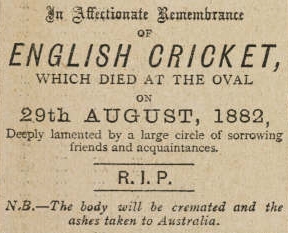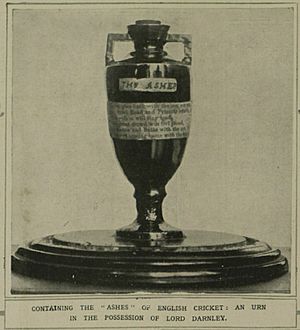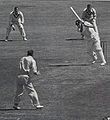The Ashes facts for kids

The Ashes urn, made of terracotta and about 10.5 cm (4") tall, is reputed to contain the ashes of a burnt cricket bail.
|
|
| Countries | |
|---|---|
| Administrator | International Cricket Council |
| Format | Test cricket |
| First edition | 1882–83 (Australia) |
| Latest edition | 2023 (England) |
| Next edition | 2025–26 (Australia) |
| Tournament format | 5-match series |
| Number of teams | 2 |
| Current trophy holder | |
| Most successful | |
| Most runs | |
| Most wickets | |
The Ashes is a famous Test cricket competition. It is played every two years between the national cricket teams of England and Australia. This exciting series has a unique history.
The name "The Ashes" started in 1882. Australia had just won a cricket match against England in England for the first time. A British newspaper, The Sporting Times, wrote a funny article. It said that English cricket had "died" and its "ashes" would be taken to Australia.
The English team's captain, Ivo Bligh, promised to "regain those ashes" on their next tour to Australia. When England won the series, a small urn was given to Bligh. People said it contained the ashes of a burnt cricket bail. This little urn became a symbol of the Ashes.
The original Ashes urn is not an official trophy. It was a personal gift to Bligh. It is kept safe in the Marylebone Cricket Club (MCC) Museum at Lord's in London. Winning teams now get a special Waterford Crystal trophy. It looks like the original urn.
Ashes series usually have five Test matches. England and Australia take turns hosting them. The team that wins the most recent series "holds" the Ashes. If a series ends in a draw, the team that held the Ashes before the series gets to keep them.
There have been 73 Ashes series in total. Australia has won 34 series and kept the Ashes six times when a series was drawn. England has won 32 series and kept the Ashes once from a draw.
Contents
The Start of the Ashes Legend in 1882
The first ever Test match between England and Australia was in 1877. But the Ashes story truly began in 1882. Australia was touring England and played one Test match in London. It was a very close game on a difficult pitch.
Australia scored only 63 runs in their first turn at bat. England then took a small lead, scoring 101 runs. In their second turn, Australia scored 122 runs. This left England needing just 85 runs to win.
The Australian team felt down after their batting collapse. But their fast bowler, Fred Spofforth, was determined. He took four wickets for only two runs. England ended up eight runs short of victory.

When England's last batsman, Ted Peate, came to bat, they needed ten runs. But Peate only scored two before he was out. The crowd was shocked that England had lost at home. People cheered loudly for the Australian bowlers.
The British newspapers wrote a lot about this big defeat. They praised Australia's courage. A famous poem appeared in Punch magazine. It asked if England lost due to bad luck or a lack of spirit.
On September 2, 1882, a famous mock obituary appeared in The Sporting Times. It was written by Reginald Shirley Brooks. It said:
In Affectionate Remembrance
of
ENGLISH CRICKET,
which died at the Oval
on
29th August, 1882,
Deeply lamented by a large circle of sorrowing
friends and acquaintances.
R.I.P.
N.B.—The body will be cremated and the
ashes taken to Australia.
This article is where the idea of "the ashes" came from. When England's captain, Ivo Bligh, led his team to Australia in 1882–83, he promised to "recover those Ashes." The Australian media loved this idea. England won that series 2–1.
For about 20 years, the term "the Ashes" was not used much. But in 1903, Pelham Warner led an English team to Australia. He also promised to regain "the ashes." The Australian media again made a big deal about it, and this time, the name stuck. Warner even wrote a book called How We Recovered the Ashes.
The Ashes Urn: A Special Memento
For many years, there was no physical trophy for the Ashes. The idea of a special urn became famous because of the one given to Ivo Bligh.

The exact story of the urn's origin is a bit unclear. It is believed that some ladies in Melbourne, Australia, gave it to Bligh. This happened after a private cricket match in December 1882. Bligh's future wife, Florence Morphy, was one of these ladies.
The urn is made of terracotta and is about 15 cm (6 inches) tall. It might have been a perfume jar originally. The contents are believed to be the ashes of a cricket bail. X-rays of the urn have shown that it is "95% certain" to contain bail ashes.
A small label with a six-line poem is stuck on the urn. This poem was published in a Melbourne newspaper in 1883. It talks about Ivo Bligh returning with the urn.
In 1927, after Bligh passed away, his wife gave the urn to the Marylebone Cricket Club (MCC). This made the urn the official symbol of the Ashes legend. The MCC displays the urn in its Cricket Museum at Lord's. It is a private keepsake, not a trophy that is given to the winning team.
Because the urn is very old and fragile, it has only traveled to Australia twice. It went in 1988 for a museum tour and again for the 2006–07 Ashes series.
Since 1998–99, the winning team receives a larger replica trophy made of Waterford Crystal. This is called the Ashes Trophy. It allows the winning team to have a trophy, while the original urn stays safe in the museum.
Ashes Series History: Key Moments
Ashes series have given us many exciting moments. Let's look at some of the most memorable periods.
England's Early Dominance (1884 to 1896)
After Bligh's victory, England was very strong. They lost only four Ashes Tests out of 23 played in the 1880s. England won all seven series during this time.
The matches in the 1890s were closer. Australia won their first series since 1882 in 1891–92. But England still mostly dominated, winning the next three series until 1896.
A famous match happened in 1894–95. England won by just 10 runs after being forced to bat again (following on). Australia had scored a huge 586 runs. But England fought back, and their bowlers, Bobby Peel and Johnny Briggs, were amazing on a wet pitch.
In 1896, England, led by W. G. Grace, won the series 2–1. This marked the end of England's longest period of Ashes dominance.
Australia's Rise (1897 to 1902)
Australia won the 1897–98 series strongly, 4–1. Their captain, Joe Darling, led them to win the next three series as well. The 1902 series was especially famous.
The 1902 series had five matches, but the first two were drawn due to bad weather. Australia won the Third and Fourth Tests. In the Fourth Test, Victor Trumper scored 104 runs very quickly on a difficult pitch. England won the last Test by just one wicket. It was a thrilling finish.
During this time, Australia had many great players. These included Trumper, Warwick Armstrong, Monty Noble, and Hugh Trumble.
The "Bodyline" Series (1932–33)
Australia had a very strong batting team in the early 1930s. They had amazing players like Donald Bradman, Archie Jackson, and Bill Ponsford. Bradman was especially incredible, scoring 974 runs in the 1930 series. This is still a world record for runs in a Test series.
To try and stop Australia's powerful batsmen, England's captain, Douglas Jardine, used a new tactic in the 1932–33 series. He told his fast bowlers, like Harold Larwood and Bill Voce, to bowl at the Australian batsmen's bodies. The idea was to make them defend themselves, leading to easy catches.
This tactic was called "Bodyline." It caused a huge argument between England and Australia. Even diplomats had to get involved! England won the series 4–1. But the MCC (Marylebone Cricket Club) later changed the rules to limit how many fielders could stand on the leg side.
Jardine famously said, "I've not travelled 6,000 miles to make friends. I'm here to win the Ashes." Australia's captain, Bill Woodfull, refused to use Bodyline back. He told England's manager, "There are two teams out there. One is playing cricket; the other is making no attempt to do so."
Australia's Long Reign (1934 to 2005)
Australia regained the Ashes in 1934 and held them until 1953. No Test cricket was played during the Second World War.
In 1934, Australia scored a massive 701 runs in one innings. Bradman scored 244 and Ponsford scored 266. Australia won the series 2–1.
After the war, Australia continued to dominate. They won the 1946–47 series 3–0. In 1948, Australia's team, led by Bradman, was called The Invincibles. They played 34 matches in England and did not lose any.
Bradman played his last innings in the final Test of 1948. He needed only four runs to have a career batting average of exactly 100. But he was out for zero runs, ending his career with an average of 99.94.
Australia continued to win most Ashes series for many years. From 1989 to 2005, Australia won almost every series. They had amazing players like Shane Warne, Glenn McGrath, and Steve Waugh. Warne's first ball in Ashes cricket in 1993, which bowled Mike Gatting, is still known as the Ball of the Century.
Recent Ashes Battles (2005 to Present)
The 2005 Ashes series was incredibly exciting. Australia won the first Test easily. But England fought back to win the second Test by just 2 runs. This was one of the closest finishes in Ashes history. England went on to win the series, taking the Ashes for the first time in 18 years.
Australia won back the Ashes in 2006–07 with a strong 5–0 victory. This was only the second time an Ashes series had been won by that margin.
England won the 2009 Ashes series at home. The first Test was a tense draw, with England's last two batsmen holding on. England then won the final Test to regain the Ashes.
In 2010–11, England won the Ashes in Australia for the first time in 24 years. They won the series 3–1, with some big victories. England's opening batsman, Alastair Cook, scored 766 runs in the series. This was the most by any batsman in an Ashes series since Bradman in 1930.
Australia won the 2013–14 Ashes series at home by a huge 5–0. This was Australia's third "whitewash" in Ashes history. Their fast bowler Mitchell Johnson took 37 wickets.
In 2015, England won the Ashes at home. They bowled Australia out for just 60 runs in one innings. England won the series 3–2.
Australia regained the Ashes in 2017–18 with a 4–0 win at home. The 2019 Ashes series in England was a 2–2 draw, so Australia kept the Ashes.
In 2021–22, Australia comfortably beat England 4–0 at home to retain the Ashes again. The series included the first Ashes Test ever played in Tasmania.
The most recent series was the 2023 Ashes series in England. Australia won the first two Tests. England fought back to win the third and fifth Tests. However, the fourth Test was a draw due to rain. This meant Australia retained the Ashes with the series ending 2-2. England's Stuart Broad announced his retirement during the final Test.
Ashes Statistics
Here are some overall results for the Ashes series:
| Tests played | Draws | ||
|---|---|---|---|
| 361 | 152 | 111 | 98 |
Series results, up to and including July 31, 2023:
| Series played | Draws | ||
|---|---|---|---|
| 73 | 34 | 32 | 7 |
A team must win a series to hold the Ashes. If a series is drawn, the team that held the Ashes before the series gets to keep them. Ashes series usually have five Test matches. Sometimes they have four or six matches.
Ashes Match Venues
The Ashes series alternates between England (and Wales) and Australia. Each match in a series is played at a different cricket ground.
Australian Grounds
In Australia, the main grounds used are:
- MCG in Melbourne
- SCG in Sydney
- Adelaide Oval in Adelaide
- The Gabba in Brisbane
The MCG usually hosts the Boxing Day Test (around December 26). The SCG hosts the New Year's Day Test. The WACA Ground in Perth hosted its last Ashes Test in 2017–18. The Bellerive Oval in Hobart hosted its first Ashes Test in 2021–22.
English Grounds
In England and Wales, the main grounds used are:
- Old Trafford in Manchester
- The Oval in London
- Lord's in London
- Headingley in Leeds
- Edgbaston in Birmingham
Other grounds that have hosted Ashes Tests include Sophia Gardens in Cardiff, Wales, and the Riverside Ground in Chester-le-Street. The final Test of the series is traditionally played at The Oval.
| * | Including abandoned tests |
| † | County cricket clubs who play at the grounds |
| ‡ | Former grounds which no longer host Test Matches |
| Stadium | State | First Test | Last Test | Played | Draws* | Ref | ||||
|---|---|---|---|---|---|---|---|---|---|---|
| MCG, Melbourne | 1882–83 | 2021–22 | 51 | 25 | 2021 | 7 | 19 | 2010 | ||
| SCG, Sydney | 1882–83 | 2021–22 | 52 | 23 | 2018 | 7 | 22 | 2011 | ||
| Adelaide Oval, Adelaide | 1884–85 | 2021–22 | 33 | 19 | 2021 | 5 | 9 | 2010 | ||
| Brisbane Exhibition Ground, Brisbane‡ | 1928–29 | 1928–29 | 1 | 0 | – | 0 | 1 | 1928 | ||
| The Gabba, Brisbane | 1932–33 | 2021–22 | 22 | 13 | 2021 | 5 | 4 | 1986 | ||
| WACA Ground, Perth‡ | 1970–71 | 2017–18 | 13 | 9 | 2017 | 3 | 1 | 1978 | ||
| Bellerive Oval, Hobart | 2021–22 | 2021–22 | 1 | 1 | 2021 | 0 | 0 | – | ||
| Stadium | County† | First Test | Last Test | Played | Draws* | Ref | ||||
|---|---|---|---|---|---|---|---|---|---|---|
| Old Trafford, Manchester | 1884 | 2023 | 33 | 7 | 1981 | 18 | 8 | 2019 | ||
| Lord's, London | 1884 | 2023 | 37 | 7 | 2013 | 14 | 16 | 2023 | ||
| The Oval, London | 1884 | 2023 | 37 | 17 | 2023 | 14 | 6 | 2015 | ||
| Trent Bridge, Nottingham | 1899 | 2015 | 22 | 6 | 2015 | 9 | 7 | 2001 | ||
| Headingley, Leeds | 1899 | 2023 | 26 | 9 | 2023 | 8 | 9 | 2009 | ||
| Edgbaston, Birmingham | 1902 | 2023 | 16 | 6 | 2015 | 5 | 5 | 2023 | ||
| Bramall Lane, Sheffield‡ | 1902 | 1902 | 1 | 0 | – | 0 | 1 | 1902 | ||
| Sophia Gardens, Cardiff | 2009 | 2015 | 2 | 1 | 2015 | 1 | 0 | – | ||
| The Riverside, Chester-le-Street | 2013 | 2013 | 1 | 1 | 2013 | 0 | 0 | – | ||
Images for kids
-
Bill Woodfull avoids a fast ball from Harold Larwood during the "Bodyline" series.
-
Andrew Flintoff scores a century at Trent Bridge in 2005.
More Cricket Information
- The Women's Ashes
- Ella-Mobbs Trophy (Rugby Union matches between England and Australia)
- Rugby League Ashes
- Soccer Ashes
See also
 In Spanish: The Ashes para niños
In Spanish: The Ashes para niños









